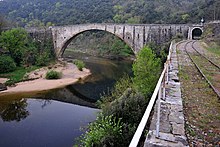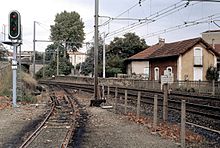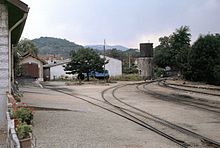Tournon – Le Cheylard railway line
| Tournon – Le Cheylard | |||||||||||||||||||||||||||||||||||||||||||||||||||||||||||||||||||||||||||||||||||||||||||||||||||||||||||||||||||||||||||||||||||||||||||||||||||||||||||||||||||||
|---|---|---|---|---|---|---|---|---|---|---|---|---|---|---|---|---|---|---|---|---|---|---|---|---|---|---|---|---|---|---|---|---|---|---|---|---|---|---|---|---|---|---|---|---|---|---|---|---|---|---|---|---|---|---|---|---|---|---|---|---|---|---|---|---|---|---|---|---|---|---|---|---|---|---|---|---|---|---|---|---|---|---|---|---|---|---|---|---|---|---|---|---|---|---|---|---|---|---|---|---|---|---|---|---|---|---|---|---|---|---|---|---|---|---|---|---|---|---|---|---|---|---|---|---|---|---|---|---|---|---|---|---|---|---|---|---|---|---|---|---|---|---|---|---|---|---|---|---|---|---|---|---|---|---|---|---|---|---|---|---|---|---|---|---|---|
|
Mixed train with Mallet locomotive 406 in Lamastre, 1960
| |||||||||||||||||||||||||||||||||||||||||||||||||||||||||||||||||||||||||||||||||||||||||||||||||||||||||||||||||||||||||||||||||||||||||||||||||||||||||||||||||||||
| Route length: | 52.28 km | ||||||||||||||||||||||||||||||||||||||||||||||||||||||||||||||||||||||||||||||||||||||||||||||||||||||||||||||||||||||||||||||||||||||||||||||||||||||||||||||||||||
| Gauge : | 1000 mm ( meter gauge ) | ||||||||||||||||||||||||||||||||||||||||||||||||||||||||||||||||||||||||||||||||||||||||||||||||||||||||||||||||||||||||||||||||||||||||||||||||||||||||||||||||||||
| Maximum slope : | 30 ‰ | ||||||||||||||||||||||||||||||||||||||||||||||||||||||||||||||||||||||||||||||||||||||||||||||||||||||||||||||||||||||||||||||||||||||||||||||||||||||||||||||||||||
| Top speed: | 40/55 km / h | ||||||||||||||||||||||||||||||||||||||||||||||||||||||||||||||||||||||||||||||||||||||||||||||||||||||||||||||||||||||||||||||||||||||||||||||||||||||||||||||||||||
|
|||||||||||||||||||||||||||||||||||||||||||||||||||||||||||||||||||||||||||||||||||||||||||||||||||||||||||||||||||||||||||||||||||||||||||||||||||||||||||||||||||||
The Tournon – Le Cheylard railway was a narrow-gauge railway in France . A section of the route has been preserved and is used by the Train de l'Ardèche museum railway .
location
The Vivarais is one of the historic provinces of France and largely congruent with today's Ardèche . Located just south of Lyon right side of the Rhone in the region Auvergne Rhône-Alpes . The low mountain range belongs geographically to the Massif Central , the eastern edge of which it forms. It is hilly with rugged valley sections in places.
route


Starting from the Rhone valley, the Tournon – Le Cheylard railway largely follows the course of the Doux river . The lowest point was the Tournon-sur-Rhône station at 123.16 meters ( Marseille gauge ), the apex was about 620 meters at about 44 kilometers. At the now abandoned Douce-Plage stop, it crosses under the northern abutment of the Pont Grand bridge the years 1379 to 1583 and runs from there to the Colombier-le-Vieux-Saint-Barthélemy-le-Plain train station through the deeply cut Gorges du Doux .
The line ended at Le Cheylard station on the La Voulte-sur-Rhône − Dunières line, which was also meter-gauge, at an altitude of 430.35 meters. The line between Lamastre and Le Cheylard was dismantled in 1970. The former railway line can now be explored on foot or by bike as part of the 75 km long “La Dolce Via” hiking trail.
In Tournon-sur-Rhône , the station and the depot were located directly next to the station on the regular -gauge Givors-Canal – Grezan railway , a main line that has only been used for freight traffic since 1973. The narrow-gauge railway systems there were largely preserved in 2015, and the three- rail track with the two junctions and safety equipment still existed.
At the northern end of the two stations, the narrow-gauge track joins the western track of the double-track main line . Originally, both directional tracks were laid out with three tracks, but the layout was greatly simplified in the early 1950s. Initially, two, 45 and 641 meter long tunnels will be driven under a slope over a length of 2.2 kilometers . Shortly before the junction from the three-rail track, the line crossed the Doux on a 134 meter long iron viaduct , which was replaced by a concrete bridge in 2005 and demolished in the same year. Immediately afterwards it leaves the common section in a westerly direction. The standard gauge line was opened by the PLM railway company in 1879 , and the three- rail track is the only one of its kind left in France. Although the operator of the museum railway had to contribute around three million euros to the construction of the new bridge, he was only allowed to use the three-rail section until 2012.
In the former St. Jean-de-Muzols train station, the buildings, tracks and switches were dismantled after 2011, and they were probably used in the newly constructed terminus Tournon – St.-Jean-de-Muzols east of the Grand Pont. The remaining tracks were still in place in 2015.
history
Construction, opening and first years
The route was created as part of the first network in Vivarais. It comprised the routes Lavoûte-sur-Loire - Yssingeaux (opened in 1890), La Voulte-sur-Rhône -Le Cheylard and Tournon-Lamastre (both opened in 1891).
The latter was put into operation by the Compagnie de chemins de fer départementaux (CFD) on July 12, 1891. According to the official specifications, the minimum curve radius was 100 m, the superstructure limited the permissible axle load to 8 t. The maximum gradient was 20 ‰. With the three- rail track in Tournon, another tunnel or a route for the branch line in the street area was avoided; payments had to be made to PLM for this.
There was only one train running on the route, commuting three times a day between the endpoints. In addition to freight cars, it drove first, second and third class passenger cars and covered the 32.6 km long route in both directions in 1:25 h, which corresponded to a cruising speed of 23 km / h. The mallet locomotives, which were barely 200 HP strong and had a trailer load of 80 t, maintained speeds of more than 32 km / h on the steady uphill gradient, which required an excellent engine driver and skilled stoker. There was also a market train that ran on Sundays.
Even before the three lines went into operation, CFD had thought about expanding them and merging them into a network. Thus the idea of the "Étoile du Cheylard" (star of Le Cheylard) arose as the intersection of two axes from Tournon to Aubenas and from La Voulte to Yssingeaux with a branch towards Dunières . In order to realize this plan it was necessary to leave the valleys and to lead the routes over the mountains. The officially approved gradients were increased to 32.5 ‰.
From July 11, 1903, the three daily train pairs and the Sunday market train in the Doux valley were extended beyond Lamastre to Le Cheylard. The 248 m long tunnel des Nonières was crossed, the difficult construction of which had delayed the opening of the section by several weeks. From then on, the operating center of the merged railways was Le Cheylard. The planned route to Aubenas was not carried out.
Both passenger and freight traffic developed positively, and the trains were often overcrowded. The CFD repeatedly requested permission to extend the Sunday market train to 24 wagons or 60 axles. A special permit was granted for this in 1913.
1914 to 1944
Personnel were drafted during World War I , locomotives and wagons were requisitioned in 1916 and coal allocations were reduced. For four years there was only one daily pair of trains, the market trains were largely eliminated. It was not uncommon for travelers to have to sit on temporary benches in freight cars. A second pair of trains was not added again until the winter of 1920, and in 1922 the old condition was finally restored.
In the 1930s, the operating company acquired light rail buses from the manufacturers De Dion-Bouton and Billard in order to survive in the face of the emerging motor vehicle traffic . In 1938 they had largely displaced the steam locomotives on the route; they were left with only goods transport, passenger transport on market days and a single mixed train. The diesel engines of the small railcars proved to be prone to failure, however, and reliable traffic could not be guaranteed before they were replaced after the Second World War .
Between 1928 and 1938, the CFD deficit had quadrupled, making the infrastructure difficult to maintain. Especially on the “main line” La Voulte – Dunières, there were repeated derailments due to the worn superstructure . The Second World War led to the rationing of allocations, so in 1942 the company received only 2,000 instead of the 14,000 thresholds requested . As early as September 1939, only two daily train pairs were running on the route, which were transported as mixed trains by steam locomotives. On January 5, 1943, a train derailed just before the Viaduc du Garnier at kilometer 23 northeast of Lamastre, where five successive sleepers had broken. Until 1947, however, there was no fundamental renewal of the tracks.
In October 1935, the route was closed for several days due to falling rocks after heavy rain. In contrast, the traffic on August 3, 1963, when the Doux rose several meters within a few minutes and carried many people with it, could be maintained.
In November 1942 the area of the unoccupied zone was occupied by the German troops . The occupiers searched the passengers in the Tournon terminus, which is why passengers with goods for the black market got off beforehand. This brought high numbers of people getting on and off at the small Saint-Jean-de-Muzols train station until 1944.
As a result of the war, during the final phase of which the CFD network was located between the area controlled by the Germans and areas held by the Resistance , traffic on the Tournon – Le Cheylard line was suspended in April 1944. The shelling of Le Cheylard at the beginning of July 1944, where the command center of the Armée Secrète was located, as well as a German air raid in the middle of that month, caused severe damage to the local railway depot and rolling stock . In addition, when the Wehrmacht withdrew , the network remained largely intact, and none of the bridges were blown up. In contrast to heavily damaged narrow-gauge railroads, this made it possible to reactivate the lines, because the Marshall Plan did not provide for funds for their reconstruction .
post war period
During the first three years after the liberation , the main repair work was carried out. The rail buses, which had been idle since the beginning of the war, were reactivated. In 1948 and 1949, the CFD acquired three diesel locomotives and thus initiated the end of steam traction in freight traffic. Although the Tournon – Le Cheylard line had the lowest deficit in the network, the Corps des ingénieurs des ponts et chaussées proposed its closure for the first time in 1951. In the following years this demand was made repeatedly, on October 31, 1968 the last train finally ran. In 1970 the track between Le Cheylard and Lamastre was dismantled, but the continuing section to Tournon was retained.
vehicles
From the beginning, wrong on the track tank locomotives with the wheel arrangement (French: 130T) 1 'C, because of the twisty track alignment and four- and six-axis machines of the type were before heavy trains but Mallet used.
After the Second World War, there was a gradual changeover from steam to diesel traction. In 1949, the “Locotracteurs” X and Y, two machines that had been built on the chassis of two steam locomotives from 1887, came onto the line. In 1963 the 207 hp small locomotive 040-003 was delivered, which first came to the CP in 1971 and to the CFC three years later .
The rail buses from De Dion-Bouton and Billard , which had been procured from 1934 and 1938 respectively, ran with one- and two-axle freight wagons if necessary, the railcars from Billard also with sidecars for passenger transport.
Mallet locomotive No. 63 of the CFD from 1891 ( SACM )
Six-axis Mallet No. 403 ( SLM ), 1968
De Dion-Bouton railcar with a single-axle trailer
CFD billiard railcars and sidecars
Museum traffic

On June 14, 1969, a museum train ran between Lamastre and Saint-Jean-de-Muzols for the first time , and seven months later the three-rail section to Tournon station could be used again. The official inauguration of the museum route took place on April 18, 1970.
Museum traffic was suspended from 2008 to 2012. To the west of St. Jean-de-Muzols, not far from the former Douce-Plage stop, the Tournon-St. Jean-de-Muzols rebuilt. Since 2013 it has served as the new starting point for the trains of the "Train de l'Ardèche" in the direction of Lamastre.
literature
- Jean Arrivetz, Pascal Bejui: Les Chemins de Fer du Vivarais . Presses et Editions Ferroviaires, Grenoble 1986, ISBN 2-905447-04-4 .
- François Collardeau, Pascal Bejui: Vivarais, Velay. Les trains du renouveau . La Régordane, La Roche-Blanche 2011, ISBN 978-2-906984-94-3 .
Individual evidence
- ↑ Jean Arrivetz, Pascal Bejui: Les Chemins de Fer du Vivarais , p 61
- ↑ Jean Arrivetz, Pascal Bejui: Les Chemins de Fer du Vivarais , p 155
- ↑ François Collardeau, Pascal Bejui: Vivarais, Velay. Les trains du renouveau , p. 86 f
- ↑ Jean Arrivetz, Pascal Bejui: Les Chemins de Fer du Vivarais , p 63
- ↑ Le Mastrou. Le train touristique de l'Ardèche from mastrou.com, accessed on January 31, 2015










